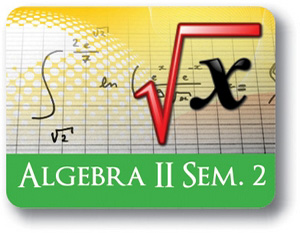
Algebra 2 builds on topics discussed in Algebra 1. Topics introduced in Algebra 2 provide a strong base for success in college prep math courses. This course emphasizes expanding critical thinking and problem-solving skills. Using technology as a tool is incorporated into the course.
Semester 2 extends the study of functions to include radical, exponential, log and trig functions. Students will simplify, graph and solve functions using a variety of methods. Students will model real world data with functions. Data collection methods, central tendency and dispersion are presented. The normal curve is studied. Two-variable data sets are analyzed and the function of best fit found.
Note: This course is not designed for ELL (English Language Learners) students. ELL students may enroll in this course ONLY if they have adequate mentor support at their home school and are able to fulfill all course requirements.
This course requires practice on GeoGebra and/or Desmos. These are both online free tools. In addition Graph paper may be needed for assignments.
Section 1: Radical Functions
introduces radical functions and their relationship to rational exponents. Mathematics operations on radical expressions is discussed as well as composition of functions. Square root and cube root functions are presented as inverse functions of a quadratic and cubic function. Composing functions is introduced as a way to determine inverse functions. Radical equations are solved.
After this section the student will be able to:
Lessons:
Sections 2: Exponential Functions
extends the study of exponential functions introduced in Algebra 1. Parent exponential functions and their translations are graphed. Base e is introduced and application to compounding interest continuously presented. Complex exponential functions are solved by writing equations with like bases. Growth and decay models are used to represent real world situations.
After this section the student will be able to:
Lessons:
Section 3: Logarithmic Functions
introduces the student to logarithmic functions as inverses to exponential functions. Log functions are graphed showing intercepts and end behavior. The properties of log functions are presented and used to simplify and evaluate log expressions. Exponential and logarithmic functions are solved using inverse operations.
After this section the student will be able to:
Lessons:
Section 4: Trigonometric Functions
extends the concepts of right triangle trigonometric learned in Geometry to all angles. The conversion from degree measure to radian measure is presented and the unit circle developed. Trigonometric functions are graphed showing period, midline and amplitude. Trig functions are used to model real world situations.
After this section the student will be able to:
Lessons:
Sections 5: Data Analysis
This section focuses on data analysis. The different methods of gathering data are presented. Data is analyzed for flaws and biases. Building on prior knowledge of central tendency and standard deviation, normal distribution is discussed. Finding the best fit curve to represent a data set is also presented.
After this section the student will be able to:
Lessons:
